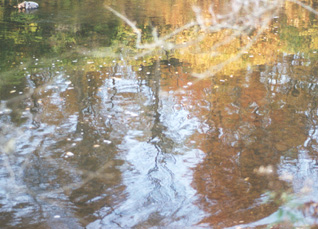

There's a bench or two placed beside the water for watchers of the reflecting light, the ripples and swirls, the leaves glissading. For people who are fascinated by the capture of light, watching light on water can be mesmerizing. A local Vermont journalist and singer, Marjorie Drysdale, has published a book entitled Water Music, comprising photographs and comments by a variety of musicians. I haven't read it yet, so can't offer any further description, but "water music" has a certain sense, even sensuousness, to the phrase.
The idyllic scene of the rowboat or canoe on a languidly flowing river, a saunter in water, the rippling flow of a brook with miniature waterfalls over each stone, the determined flow of the North Branch's wide stream in autumn, the roar of rapids, the slap of waves on granite slabs beside a lake. Most of us have a memory of some kind of water music. And usually it's freshwater music.
I have just begun a book entitled Blue Gold: The Fight to Stop the Corporate Theft of the World's Water by Maude Barlow and Tony Clarke. While we know that oil is a finite resource that will eventually be tapped out and used up, we don't tend to think of water that way. I offer their statistics about water: of all the water on the globe, only 2.6 percent (36 million cubic kilometers) is fresh water (not salt) and of this small amount, only 0.77 percent (11 million cubic kilometers) is part of the circulating water cycle. And the amount that can be relied upon for human use is what falls as rain (a dramatically lower number of 34,000 cubic kilometers) that runs off to the oceans. This is the portion of water that can be "harvested" without depleting finite water sources, such as aquifers.
Fresh water can be the commodity that nations will fight for, as the world's population show little sign of abating its exponential growth. Or it can be the commons belonging "to the Earth and all species, and therefore must not be treated as a private commodity to be bought, sold, and traded for profit....a shared legacy, a public trust, and a fundamental human right, and therefore, a collective responsibility." [From The Treaty Initiative to Share and Protect the Global Water Commons, endorsed at the Water for People and Nature summit in Vancouver, B.C., July 8, 2001.]
As you lift that bottle or glass of water, know that you hold treasure. And know also, that every person on this planet deserves sufficient water for their healthy well-being, and know that it doesn't happen. Nor does the corporatocracy of world want it to happen.
Has your consciousness about water been raised?
Cherie